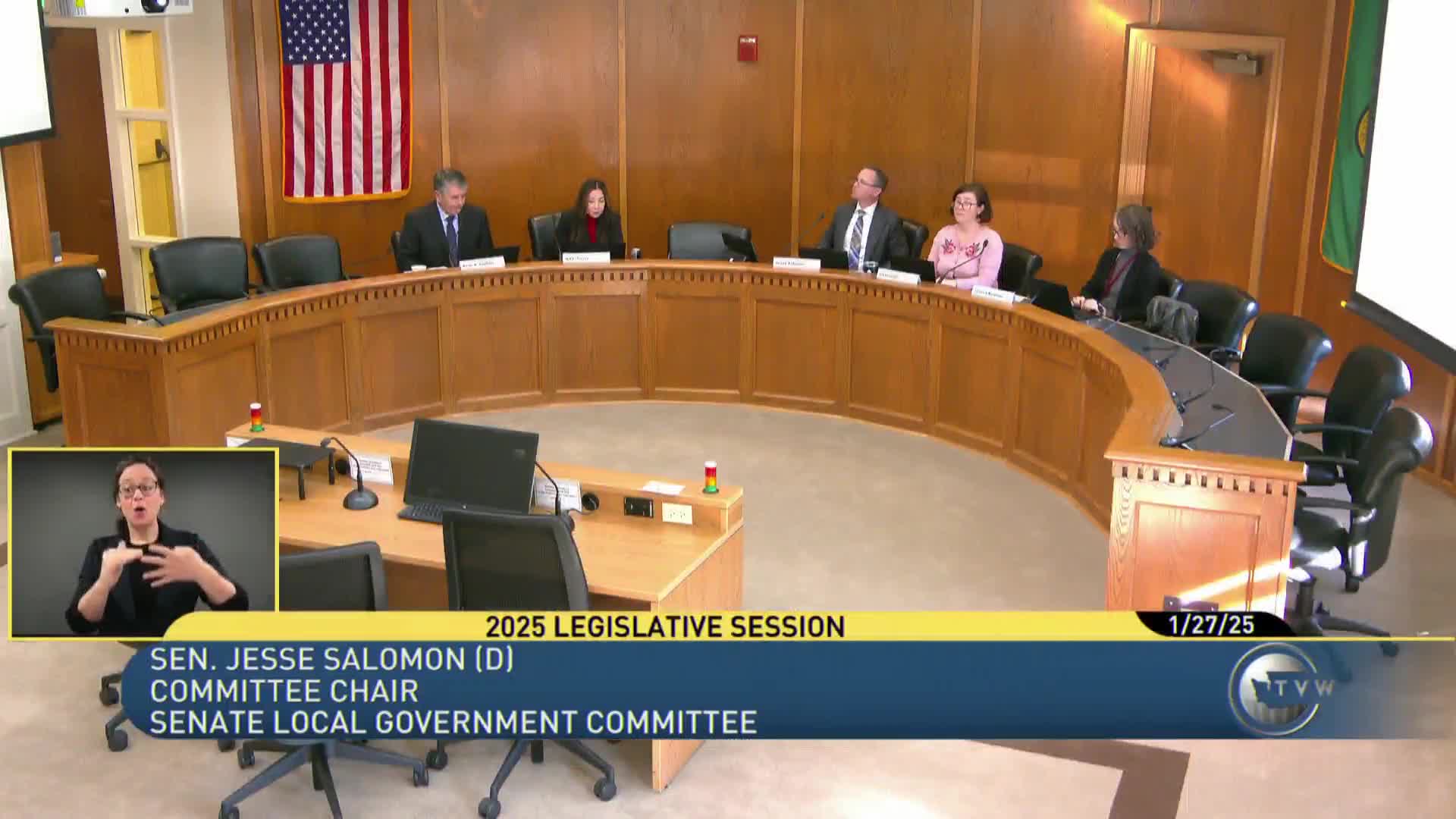Bill would let local governments impose 0.1% sales-tax credit to fund commissioned officers, boost police academy classes
January 27, 2025 | Local Government, Land Use & Tribal Affairs, Senate, Legislative Sessions, Washington
This article was created by AI summarizing key points discussed. AI makes mistakes, so for full details and context, please refer to the video of the full meeting. Please report any errors so we can fix them. Report an error »

Senate Bill 5285, presented at a Local Government, Land Use & Tribal Affairs Committee hearing, would allow cities and counties to impose a 0.1 percentage-point local sales-and-use tax, credited against the state tax, to raise revenue dedicated to employing additional commissioned law enforcement officers. The bill would also require the Criminal Justice Training Commission (CJTC) to provide at least 27 Basic Law Enforcement Training (BLET) classes beginning in fiscal 2026 and 28 classes beginning in fiscal 2027.
Committee staff said the tax is credited against the state rate so consumers would not face an additional total sales-tax increase; if both a county and a city adopt the tax, the city’s share must be credited against the county. The bill allows jurisdictions whose officer-per-capita rate exceeds the national average to use the revenue for other criminal-justice purposes in that year, the staff briefing said. A partial fiscal note presented to the committee estimated that the crediting mechanism would reduce state revenue by about $350 million in the 2025–27 biennium and about $528 million in the 2027–29 biennium, assuming broad adoption.
Senator Jeff Holy, the bill sponsor, framed the measure as a tool for smaller jurisdictions to generate recurring revenue that can help them meet matching requirements in other grant programs intended to increase officer staffing. Several municipal and business groups testified in support. Candice Bock of the Association of Washington Cities said the tax could create ongoing revenue for jurisdictions with sufficient sales-tax base but suggested flexibility in the bill’s “officers per capita” threshold so communities could set locally appropriate staffing targets. Mark Johnson of the Washington Retail Association said the bill would help address organized retail crime by bolstering local law enforcement.
James McMahon, policy director for the Association of Sheriffs and Police Chiefs, said Washington ranks last among states on officers-per-capita and argued that hiring more officers reduces victimization and improves response times; he presented numeric estimates of shortfalls and the potential cost to reach average staffing levels.
Committee members and witnesses discussed several implementation questions: how “additional officers” would be defined and sustained over time, whether tax proceeds could be used to retain existing officers if jurisdictions could not afford both existing payroll and new hires, and the 30-officer threshold CJTC uses to start a BLET class. The Association of Washington Cities asked for flexibility on the per-capita trigger and the minimum number of recruits required to start an academy class, noting some regional academies have had slightly fewer than 30 recruits and must delay classes.
Public testimony included a Buckley resident who voiced support while urging caution on tax levels, and a regional chamber official who supported the bill as a partnership opportunity. The hearing produced policy debate and stakeholder suggestions but no committee vote was recorded that day.
Committee staff said the tax is credited against the state rate so consumers would not face an additional total sales-tax increase; if both a county and a city adopt the tax, the city’s share must be credited against the county. The bill allows jurisdictions whose officer-per-capita rate exceeds the national average to use the revenue for other criminal-justice purposes in that year, the staff briefing said. A partial fiscal note presented to the committee estimated that the crediting mechanism would reduce state revenue by about $350 million in the 2025–27 biennium and about $528 million in the 2027–29 biennium, assuming broad adoption.
Senator Jeff Holy, the bill sponsor, framed the measure as a tool for smaller jurisdictions to generate recurring revenue that can help them meet matching requirements in other grant programs intended to increase officer staffing. Several municipal and business groups testified in support. Candice Bock of the Association of Washington Cities said the tax could create ongoing revenue for jurisdictions with sufficient sales-tax base but suggested flexibility in the bill’s “officers per capita” threshold so communities could set locally appropriate staffing targets. Mark Johnson of the Washington Retail Association said the bill would help address organized retail crime by bolstering local law enforcement.
James McMahon, policy director for the Association of Sheriffs and Police Chiefs, said Washington ranks last among states on officers-per-capita and argued that hiring more officers reduces victimization and improves response times; he presented numeric estimates of shortfalls and the potential cost to reach average staffing levels.
Committee members and witnesses discussed several implementation questions: how “additional officers” would be defined and sustained over time, whether tax proceeds could be used to retain existing officers if jurisdictions could not afford both existing payroll and new hires, and the 30-officer threshold CJTC uses to start a BLET class. The Association of Washington Cities asked for flexibility on the per-capita trigger and the minimum number of recruits required to start an academy class, noting some regional academies have had slightly fewer than 30 recruits and must delay classes.
Public testimony included a Buckley resident who voiced support while urging caution on tax levels, and a regional chamber official who supported the bill as a partnership opportunity. The hearing produced policy debate and stakeholder suggestions but no committee vote was recorded that day.
View full meeting
This article is based on a recent meeting—watch the full video and explore the complete transcript for deeper insights into the discussion.
View full meeting
